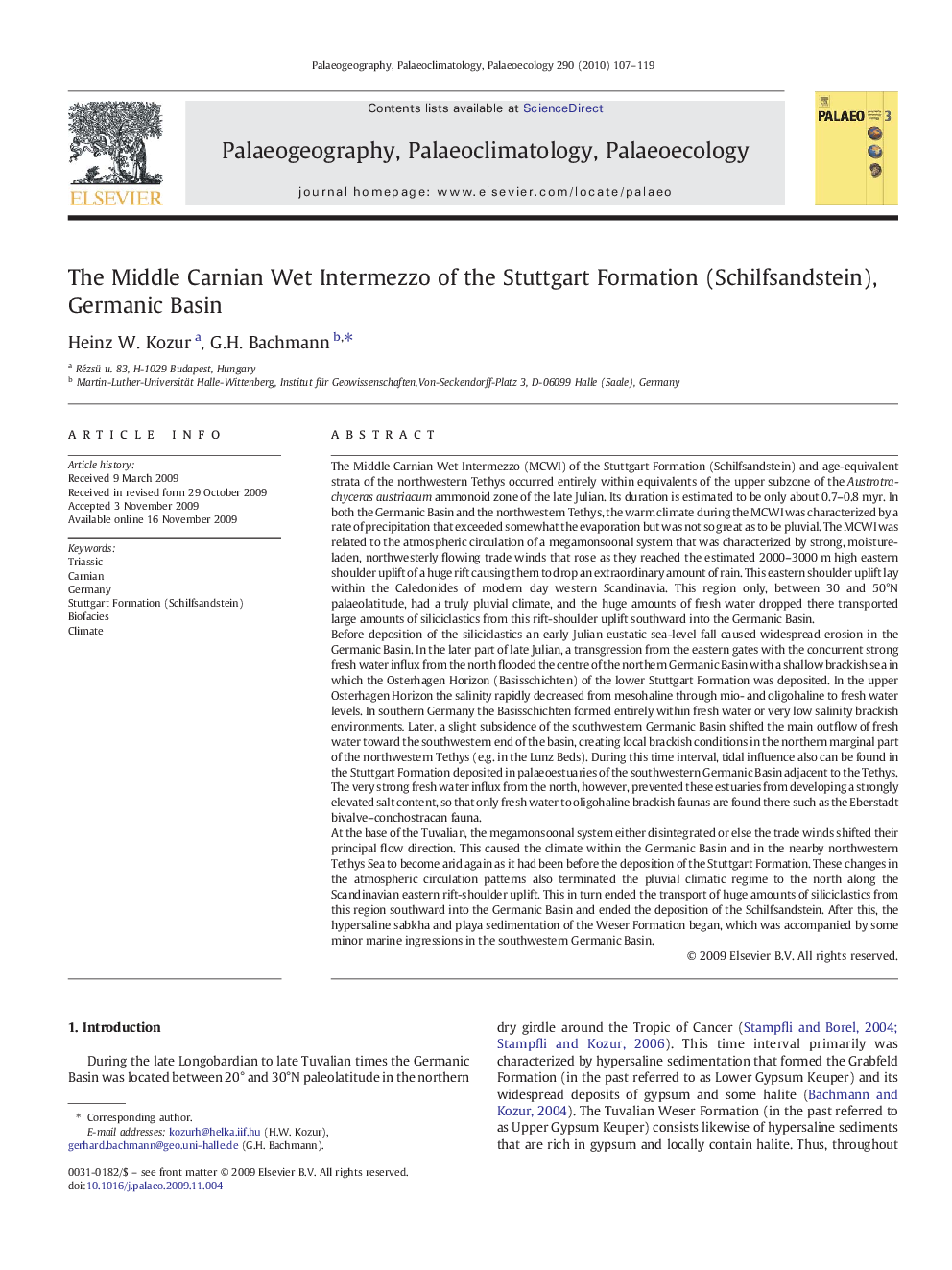| کد مقاله | کد نشریه | سال انتشار | مقاله انگلیسی | نسخه تمام متن |
|---|---|---|---|---|
| 4467782 | 1622281 | 2010 | 13 صفحه PDF | دانلود رایگان |

The Middle Carnian Wet Intermezzo (MCWI) of the Stuttgart Formation (Schilfsandstein) and age-equivalent strata of the northwestern Tethys occurred entirely within equivalents of the upper subzone of the Austrotrachyceras austriacum ammonoid zone of the late Julian. Its duration is estimated to be only about 0.7–0.8 myr. In both the Germanic Basin and the northwestern Tethys, the warm climate during the MCWI was characterized by a rate of precipitation that exceeded somewhat the evaporation but was not so great as to be pluvial. The MCWI was related to the atmospheric circulation of a megamonsoonal system that was characterized by strong, moisture-laden, northwesterly flowing trade winds that rose as they reached the estimated 2000–3000 m high eastern shoulder uplift of a huge rift causing them to drop an extraordinary amount of rain. This eastern shoulder uplift lay within the Caledonides of modern day western Scandinavia. This region only, between 30 and 50°N palaeolatitude, had a truly pluvial climate, and the huge amounts of fresh water dropped there transported large amounts of siliciclastics from this rift-shoulder uplift southward into the Germanic Basin.Before deposition of the siliciclastics an early Julian eustatic sea-level fall caused widespread erosion in the Germanic Basin. In the later part of late Julian, a transgression from the eastern gates with the concurrent strong fresh water influx from the north flooded the centre of the northern Germanic Basin with a shallow brackish sea in which the Osterhagen Horizon (Basisschichten) of the lower Stuttgart Formation was deposited. In the upper Osterhagen Horizon the salinity rapidly decreased from mesohaline through mio- and oligohaline to fresh water levels. In southern Germany the Basisschichten formed entirely within fresh water or very low salinity brackish environments. Later, a slight subsidence of the southwestern Germanic Basin shifted the main outflow of fresh water toward the southwestern end of the basin, creating local brackish conditions in the northern marginal part of the northwestern Tethys (e.g. in the Lunz Beds). During this time interval, tidal influence also can be found in the Stuttgart Formation deposited in palaeoestuaries of the southwestern Germanic Basin adjacent to the Tethys. The very strong fresh water influx from the north, however, prevented these estuaries from developing a strongly elevated salt content, so that only fresh water to oligohaline brackish faunas are found there such as the Eberstadt bivalve–conchostracan fauna.At the base of the Tuvalian, the megamonsoonal system either disintegrated or else the trade winds shifted their principal flow direction. This caused the climate within the Germanic Basin and in the nearby northwestern Tethys Sea to become arid again as it had been before the deposition of the Stuttgart Formation. These changes in the atmospheric circulation patterns also terminated the pluvial climatic regime to the north along the Scandinavian eastern rift-shoulder uplift. This in turn ended the transport of huge amounts of siliciclastics from this region southward into the Germanic Basin and ended the deposition of the Schilfsandstein. After this, the hypersaline sabkha and playa sedimentation of the Weser Formation began, which was accompanied by some minor marine ingressions in the southwestern Germanic Basin.
Journal: Palaeogeography, Palaeoclimatology, Palaeoecology - Volume 290, Issues 1–4, 15 April 2010, Pages 107–119